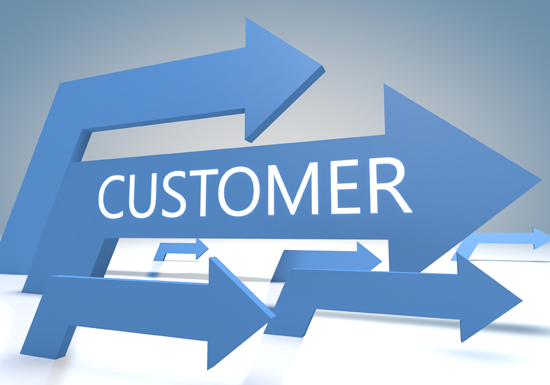Improving the 3 E's of Customer Experience

How do you shop? Admittedly, it's an innocent question, yet it will garner a multitude of answers. The general public has options; most notably, shopping in an actual store, and shopping online. Each experience has benefits as well as limitations. The key for success as a business is creating a consistent experience between the two very different environments.
Psychologists have found that it is a natural human instinct to make what is perceived as a "safe" choice and do nothing when presented with too many options. People tend to get overwhelmed, and consequently they freeze. It surely seems as though Steve Jobs read this study; after all, Apple stores are laid out so as to minimize distraction. The entire in-store experience is streamlined from entry to exit, and even their website offers the same clean, minimalist approach. With this in mind, let's look at how both in-store and online shopping can be enhanced.
Enter

People often say, "you only get one chance to make a good first impression." This is surely true of stores. Upon entering, a customer should immediately feel welcomed. The aforementioned Apple store will usually have a staff member greet and guide the customer to the product or service that they seek. Other stores provide a greeter who will verbally welcome customers, while being available to point them in the direction of the product they need. This is a basic part of providing exceptional customer service, but how can it be translated to the virtual store?
Online stores can in fact emulate the experience of being greeted in a simple manner: a short video can offer an introduction about those behind the business, the company itself, and its products and services. Descriptive written content is still necessary for the page, but a video will provide a personal touch sometimes missing from the online experience.
Another personal touch that can be incorporated into a virtual store is live chat. This method has grown as a customer service element and has often led to increased conversions for a website. As another option for greeting a visitor and prospective customer to the site, live chat creates that interactive experience usually reserved for traditional outlets.
Exhibition

Now that the customer has entered the store, it's "showtime." One must have the impressive quality exhibited at a trade show, but in a more permanent setting. Appealing to all five senses is a great way to keep the customer engaged. Additionally, providing the opportunity to interact with a given product or service can increase the likelihood of purchase. These opportunities may manifest as functional displays, demos, fitting rooms (in the case of clothing) and samples (for food, beverage, and even beauty products).
Unfortunately, virtual reality has not yet advanced enough to provide the same, hands-on experience online. However, a business can offer alternatives in the site to compensate. Multimedia is one such alternative: 'multimedia' can include high-resolution images, 360-degree video presentation, in-depth product descriptions and customer reviews.
These features provide information to help customers get more insight regarding the products and services offered. Another alternative is profile personalization. While a virtual shopping cart contains products the customer may purchase, they can also provide more features. These include providing recommendations of similar or complementary products to those in the cart, saving items on a wish list and acting as a virtual concierge.
Exit

People are often in a hurry. Waiting in checkout lines slows down the entire in-person shopping process, making online purchasing an advantageous alternative. While self-checkout, in-store pickup and NFC-enabled smartphones are making the process generally better, providing both options for customers is the best way to ensure they will continue to shop with a business.
How to Provide a Memorable Shopping Experience

Once a customer has bought a product, that doesn't mean their experience is over. The service they receive while they exit should be just as positive and memorable as what they experienced when entering. The customer should be satisfied at attaining the product or service they desired; pricing errors, unaccepted coupons and non-functioning gift cards can taint their entire experience.
This is true of both in-store and online purchases. A business should instead strive to make the experience positively memorable. Some examples of this include:
Amazon
Amazon.com offers 1-Click ordering. Coupled with personalized profiles, a completely quick and painless purchase is usually possible. Of course, this function is usually reserved for return customers. However, on a first visit and with an initial purchase, the checkout process should be just as streamlined. A customer should know at all times where they are at in the process.
Delivery & Return Policy
Customer satisfaction is, of course, the number one goal; with an online purchase, this may sometimes be harder to ensure. Therefore, quality shipping and a simple return policy can help alleviate any issues. Easy returns, whether online or in-store, encourage shoppers to buy and try a product and can be especially useful for retail clothing websites.
Free shipping
Free shipping has nearly become a standard in online shopping. In fact, most customers have come to expect it. Even if a business can't always offer free shipping, using it as an incentive when a customer purchases a certain amount can encourage them to buy more (in which case, it's likely more feasible from an economic standpoint as well).
Whether in store or online, make the shopping experience memorable for the customer. A business must greet them warmly, display products in a clean and simple manner, offer ways to interact with those products and streamline the purchasing process.
If the shopping experience is positive and memorable, a business will have loyal customers. If the experience is negative, or worse, so bad it is memorable for the wrong reasons, the customer is unlikely to ever return. Whether they shop in-store or online, a customer should be able to experience the consistent, dependable best a business has to offer.







